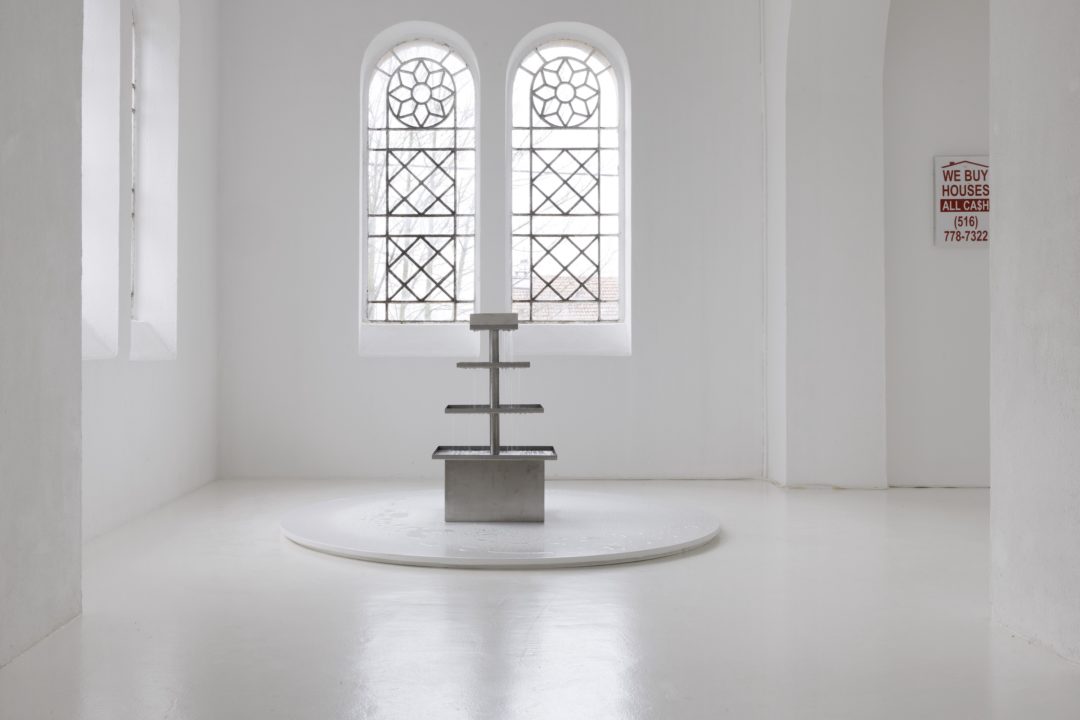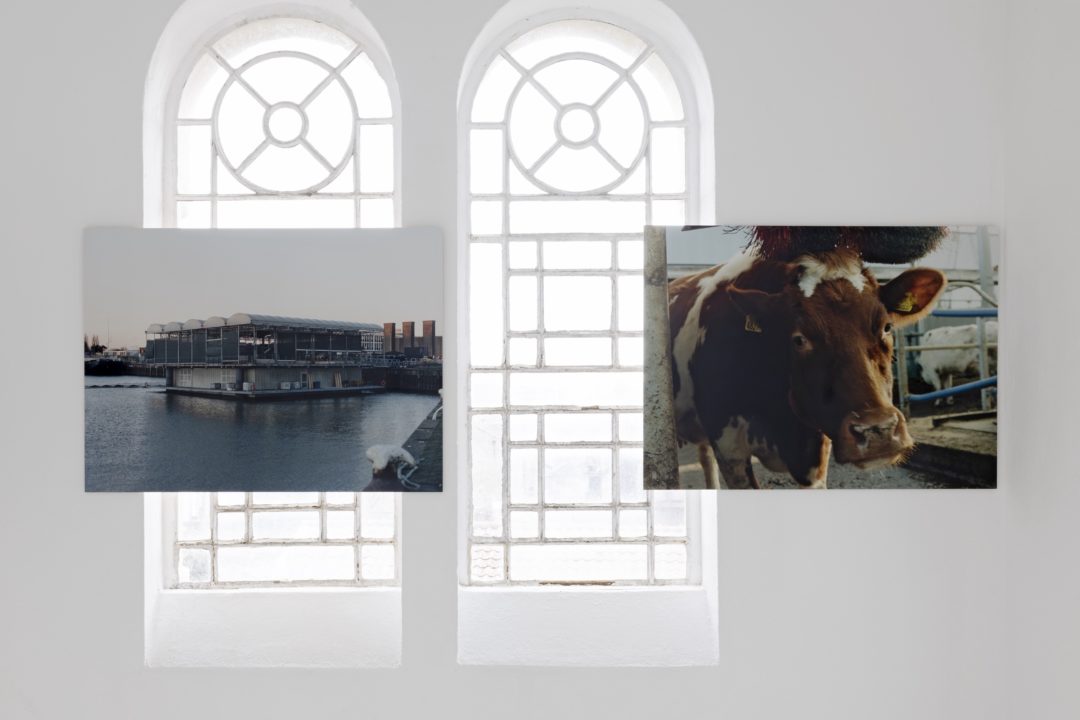Gina Folly at la synagogue de Delme

When you enter the synagogue in Delme, you are warned that you are boarding a ship of servitude, or almost. This is the term used to describe old merchant ships that were dismasted and then immobilised in ports to be used as storage spaces for equipment, additional accommodation or floating prisons.
On the ground floor, the architecture opens up above us as far as the central dome, and a floor appears at the sides, made up of three passageways, along which we can only guess at the passage of bodies, their circulation organised by the layout of the works on display; we can project the source of this continuous noise that seems to come from above, something like the murmur of a stream or a leak of water. Floating images appear beside us, flush with the wall and flush with the window, and sometimes in between. These are photographs glued to thin wooden panels, so that the light cannot penetrate them when they are placed in front of the windows; so much so that, when we look at them, we have the illusion of observing two distinct planes of reality, strangely superimposed: the interior of the building, cubic and immaculately white, and a series of photographs showing us, in very close-up, the udders of cows (Milk I – XXXII, 2024). We see the skin stretched taut by the milk and the animal’s swollen veins; the hair under the rumen and the down to which the earth spread on the ground clings and dries, only visible in the background. As the images unfold, our gaze focuses on deciphering this rigid, metallic floor: it’s the floor of a building where we see the machinery with its milking arms reaching out and grabbing the udders.

What we are shown is a floating farm in the port of Rotterdam, where dozens of cows are reared all year round for their milk. The breeding technique is presented as the prototype of an energy self-sufficient, fully automated structure, a model of short circuits and an arch likely to respond to the most contemporary ecological and agricultural concerns. It’s a construction that makes us think about the way we organise animal behaviour, like the translucent plastic boxes hung high up in the space (Magic Box IX-XIV, 2024). These are modelled on the boxes used in some zoos to feed and stimulate the great apes, who have to work out how to slide the food up several flights of stairs before they can reach it.
The presence of one of these boxes in the staircase re-enacts and translates the impression we had upon entering the exhibition space, where we could perceive the height and volume of the architecture without having a clear view of the floor above us. It was an impression of an impeded perspective, accentuated by the use of close-ups in the photographs presented. It’s when you get upstairs that you gain perspective, including in the new shots on display, which follow the rhythm of the earlier ones. We see the building from the outside, parked between a few cars on the outskirts of the port and, in the background, a cruise ship.
We also see the cows, their whole bodies, one of them being massaged by a machine triggered by her milking. The second instance of this reward system logic, which we would like to compare with the notion of incentive, the economic incentive, which corresponds to ways of modulating consumption and work behaviour in exchange for certain advantages. This is a recurring theme in the artist’s work, and here she presents two advertising billboards found in New York in 2018: WE BUY HOUSES ALL CASH. These billboards feature nothing but this phrase written in capital letters, with the exception of a minimal drawing: two lines forming a roof and referring to the pediment of the synagogue exactly opposite. It’s a reminder that Gina Folly’s very first solo exhibition in France raises questions that also, and perhaps above all, concern our ways of living. And it does so on the basis of a very specific historical fact: for a time, the Jewish community in Delme did not have the right to own land, although it had to farm livestock to make a living.

In this way, the exhibition builds on the echoes and gaps between the works – without excluding a touch of humour that marks a final retreat by the artist from her subject: one of the shots shows cows grazing on grass where a few birds are sitting, again with the sound of a stream in the background. Gina Folly is Swiss, and ‘The Simple Life’ exhibition is produced in partnership with the Centre Culturel Suisse, as part of its ‘On Tour’ programme. Finally, it’s an opportunity to consider the origin of the sound of water that accompanied our entire visit: Youth (2015) is a three-tiered fountain, with three platforms on which we are used to finding bottles of water or pieces of fruit. This fountain was produced during one of the artist’s residencies in Rome, where there are dozens like this one, usually placed close to others, ‘real’ ones, like their extensions, designed to refresh the tourists who visit them.
1 Closed until 2025 for major renovation work, the Centre culturel suisse (CCS) is leaving Paris and touring France. Since September 2022, the CCS On Tour has travelled to Rennes, Marseille, Dunkerque, Lyon and Bordeaux, and will stop off in Metz in May 2024 to present the Swiss contemporary art scene in all its forms and diversity, thanks to a solid network of local cultural partners. (DP)
______________________________________________________________________________
Head image : Vue de l’exposition « The Simple Life » de Gina Folly, 2024, centre d’art contemporain – la synagogue de Delme. Photo : Gina Folly.
- From the issue: 108
- Share: ,
- By the same author: Design Sediments at Huidenclub, Rotterdam, Petticoat Government,
Related articles
On the High Line
by Warren Neidich
Lyon Biennial
by Patrice Joly
Not Everything is Given, Whitney ISP, New York
by Warren Neidich

